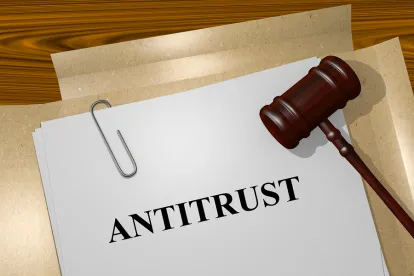While the Department of Justice's enforcement and policy priorities change from administration to administration, one priority has not, dating to the Clinton era: The DOJ's Antitrust Division loves to prosecute price-fixing cartels and will use every tool at its disposal to obtain eye-popping fines and jail sentences for the worst offenders. From 2012-2015, the DOJ collected more than $1 billion each year (largely driven by the exposure of sprawling international cartels in the auto parts and financial services industries), culminating in 2015's record-breaking $3.6 billion collection. Today, the DOJ is slated to go to trial in six criminal matters, with more likely to be scheduled — at the close of 2018, it had 91 grand jury investigations proceeding in various stages.
It is widely acknowledged that the Antitrust Division's "Corporate Leniency Program," launched in 1993, is principally responsible for the success of its criminal efforts. The program takes advantage of game theory by presenting conspirators with a carrot — immunity from prosecution to the first cartel member to "defect" by confessing and cooperating with federal law enforcement — or a stick — the wrath of the Division and maximum penalties under the Sentencing Guidelines for those left behind (although there are modest incentives for firms that cooperate second, third, and perhaps thereafter, if their information is valuable). Getting "in" first is so important that there are stories of attorneys for various cartel members bumping into one another in the DOJ's waiting area, following the sounding of an industrywide fire alarm. The outsized rewards and punishment sows distrust within cartels and can destabilize them, preventing their formation in hopeful cases and hastening their demise in others.
One aspect of the Leniency Program has involved giving credit to the defendant, at sentencing, for maintaining or implementing an effective antitrust compliance program. DOJ prosecutors were not permitted, however, to give any credit to a defendant at the charging stage. This reduced the incentive to invest in and enforce compliance programs, since one firm could obtain complete immunity by being first to cooperate even without a compliance program in place, while another could get charged with the mother lode though it may have a state-of-the-art program.
In a major shift to this aspect of the Leniency Program, earlier this month Makan Delrahim, assistant attorney general of the DOJ's Antitrust Division, announced that the Division will now be crediting compliance efforts at both the charging and sentencing stages for a criminal antitrust defendant. A reporting firm with a strong compliance program — a program that, for example, was responsible for detecting the violation the firm is now reporting — may even obtain a deferred prosecution agreement as a resolution of the violation in certain cases, and avoid prosecution if certain conditions are met. The DOJ has, for the first time, published a guidance document explaining how it will evaluate and potentially credit corporate compliance programs. Although it doesn't have the force of law, this guidance is important because it discloses how the DOJ will evaluate these issues internally, allowing companies to tailor their programs to maximize the protection and benefits that such programs engender.
Going forward, DOJ prosecutors will consider:
- The design and comprehensiveness of the program, i.e., is the program a "paper program," or a real one with standards, procedures, training, and supervision, and does it reach and empower all relevant personnel up and down a firm's supply and corporate chain;
- The culture of compliance within the company, focusing on whether and how the firm and its management actively promote a culture of compliance and ethical conduct among employees;
- Responsibility for, and resources dedicated to, antitrust compliance, which examines such issues as the program's prominence within the firm, the seniority and autonomy of personnel involved, and the time devoted to institution, maintenance, and enforcement of the program;
- Antitrust risk assessment techniques, recognizing that proper risk assessment can and should be tailored to the duties of, and potential risks associated with, a firm's various departments. The antitrust issues associated with, for example, the HR department's recruitment (or non-recruitment) of employees from a competitor are very different from those associated with the sales department's participation in industry fares, or the engineering department's participation in a standard-setting organization, or the government affairs department's participation in a trade group, and an effective program will reflect those differences. The DOJ will also examine whether relevant metrics are being collected and assessed, and whether risk assessments are kept current and reviewed.
- Compliance training and communication to employees, on which even the best compliance program will rise and fall, examining the nature and frequency of training, its comprehensiveness (both as to issues and to personnel required to receive training), follow-up testing, and revisions as needed to comply with changes in the law;
- Monitoring and auditing techniques, including continued review, evaluation, and revision of the antitrust compliance program;
- Reporting mechanisms, including positive or negative ramifications for employees reporting violations, and protections of such employees, and disciplinary measures for those who fail to report;
- Compliance incentives and discipline, looking at whether the firm rewards those who effectively promote a culture of compliance, and punish those who do not; and
- Remediation methods, including whether and how the program has been modified to account for the fact that despite its existence, the firm still violated the law, and how it will prevent such activities from taking place again. The DOJ is particularly interested in whether the program in place was responsible for identifying the violation, and the steps taken once ferreted out.
An effective antitrust compliance program is, accordingly, not just good business, but a potential lifeline to firms staring down the prospect of tens of millions of dollars in potential government fines even before the class action bar, threatening treble damages, starts to pile on. Cases have been prosecuted or not, and won or lost, based on avoidable slip-ups, including just a few foolish emails sent by sales personnel or mid-level managers (and plenty from higher-ups); side conversations at industry trade shows set up (usually lawfully) to advance industry output marketwide; actions taken by participants in otherwise lawful joint ventures; and decisions made by industry members doing the vital work of facilitating industrywide standards for the mutual benefit of firms and their customers (among many other ways that firms, inadvertently or not, cross the line).




 />i
/>i
